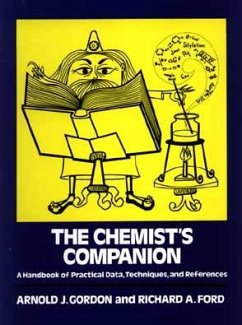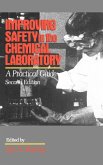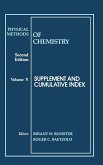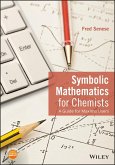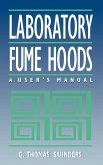Arnold J Gordon, Richard A Ford
The Chemist's Companion
A Handbook of Practical Data, Techniques, and References
Arnold J Gordon, Richard A Ford
The Chemist's Companion
A Handbook of Practical Data, Techniques, and References
- Gebundenes Buch
- Merkliste
- Auf die Merkliste
- Bewerten Bewerten
- Teilen
- Produkt teilen
- Produkterinnerung
- Produkterinnerung
information, such as names and addresses of microanalysis companies and chemistry publishers, descriptions and commercial sources of atomic and molecular models, and safety data for hazardous chemicals. More than 500 key references are also included, most of which are recent. There are important hints and definitions associated with the art as well as the state of the art for the appropriate subjects. Also found throughout the book are about 250 suppliers and directions for obtaining special booklets or other material. Containing a wealth of useful information, The Chemists Companion will be…mehr
Andere Kunden interessierten sich auch für
![Improving Safety in the Chemical Laboratory Improving Safety in the Chemical Laboratory]() Improving Safety in the Chemical Laboratory314,99 €
Improving Safety in the Chemical Laboratory314,99 €![Physical Methods of Chemistry, Supplement and Cumulative Index Physical Methods of Chemistry, Supplement and Cumulative Index]() Physical Methods of Chemistry, Supplement and Cumulative Index735,99 €
Physical Methods of Chemistry, Supplement and Cumulative Index735,99 €![Symbolic Mathematics for Chemists Symbolic Mathematics for Chemists]() Fred SeneseSymbolic Mathematics for Chemists87,99 €
Fred SeneseSymbolic Mathematics for Chemists87,99 €![Safe Storage of Laboratory Chemicals Safe Storage of Laboratory Chemicals]() Safe Storage of Laboratory Chemicals351,99 €
Safe Storage of Laboratory Chemicals351,99 €![Pigment Handbook, Volume 3 Pigment Handbook, Volume 3]() Pigment Handbook, Volume 3817,99 €
Pigment Handbook, Volume 3817,99 €![Pigment Handbook, Volume 2 Pigment Handbook, Volume 2]() Pigment Handbook, Volume 2817,99 €
Pigment Handbook, Volume 2817,99 €![Laboratory Fume Hoods Laboratory Fume Hoods]() G Thomas SaundersLaboratory Fume Hoods158,99 €
G Thomas SaundersLaboratory Fume Hoods158,99 €-
-
-
information, such as names and addresses of microanalysis companies and chemistry publishers, descriptions and commercial sources of atomic and molecular models, and safety data for hazardous chemicals. More than 500 key references are also included, most of which are recent. There are important hints and definitions associated with the art as well as the state of the art for the appropriate subjects. Also found throughout the book are about 250 suppliers and directions for obtaining special booklets or other material. Containing a wealth of useful information, The Chemists Companion will be an indispensable guide for students and professional chemists in nearly all the chemical disciplines. In addition, it will provide for the teacher and student an unusual adjunct for use in a broad cross-section of chemistry courses.
Hinweis: Dieser Artikel kann nur an eine deutsche Lieferadresse ausgeliefert werden.
Hinweis: Dieser Artikel kann nur an eine deutsche Lieferadresse ausgeliefert werden.
Produktdetails
- Produktdetails
- Verlag: Wiley
- Seitenzahl: 560
- Erscheinungstermin: 19. Januar 1973
- Englisch
- Abmessung: 290mm x 225mm x 31mm
- Gewicht: 1583g
- ISBN-13: 9780471315902
- ISBN-10: 0471315907
- Artikelnr.: 21600161
- Herstellerkennzeichnung
- Libri GmbH
- Europaallee 1
- 36244 Bad Hersfeld
- gpsr@libri.de
- Verlag: Wiley
- Seitenzahl: 560
- Erscheinungstermin: 19. Januar 1973
- Englisch
- Abmessung: 290mm x 225mm x 31mm
- Gewicht: 1583g
- ISBN-13: 9780471315902
- ISBN-10: 0471315907
- Artikelnr.: 21600161
- Herstellerkennzeichnung
- Libri GmbH
- Europaallee 1
- 36244 Bad Hersfeld
- gpsr@libri.de
About the Authors ARNOLD J. GORDON is Associate Director of Scientific Affairs at Pfizer Pharmaceuticals. He was previously a member of the chemistry faculty of the Catholic University of America. Dr. Gordon received a B.S. degree in Chemical Engineering from Northeastern University and a Ph.D. degree in Organic Chemistry from New York University. He is the author of more than 25 articles published in journals and books in such diverse areas as stereochemistry, synthesis, new drug development, organic semiconductors and chemical education. R. A. FORD is Assistant Professor at Montgomery College in Takoma Park, Maryland. He was previously Assistant Professor at Catholic University. Dr. Ford received a Ph.D. degree at Wayne State University.
Properties of Molecular Systems
I. Properties of Solvents and Common Liquids
II. Azeotropic Data
III. Empirical Boiling Point-Pressure Relationships
IV. Properties of Selected Gases
V. Properties of Representative Fused Salt Systems
VI. Structure and Properties of Naturally Occurring -Amino Acids
VII. Properties and Applications of Liquid Crystals
VIII. Prototropic Tautomerism
IX. Acids and Bases
Properties of Atoms and Bonds
I. Properties of the Elements
II. Table of Isotopes
III. Selected Bond Lengths
IV. Effective van der Waals Radii
V. Bond Angles and Hybridization
VI. Selected Bond Strengths
VII. Force Constants
VIII. Torsion and Inversion Barriers
IX. Bond and Group Dipole Moments
X. Aromaticity
Kinetics and Energetics
I. Activation Parameters and Kinetics of Selected Reactions
II. Linear Free Energy Relationships
III. Conformational Free Energy Values
IV. Free Energy-Composition Chart
Spectroscopy
I. The Electromagnetic Spectrum
II. Solvents and Other Media for Spectral Measurements
III. Optical Materials for Spectroscopy and Photochemistry
IV. Vibration Spectra
V. Electronic Absorption and Emission Spectra: UV and Vis
VI. Optical Activity and Optical Rotation
VII. Mass Spectrometry
VIII. Nuclear Magnetic Resonance Spectroscopy
IX. Electron Spin Resonance Spectroscopy
X. Nuclear Quadrupole Resonance Spectroscopy
XI. Bibliography of Spectral Data Compilations
Photochemistry
I. Electronic Energy State Diagram
II. Excited State Energy Transfer: Sensitizers and Quenchers
III. Photochemistry Light Sources and Equipment
IV. Chemical Actinometry: Quantum Yield
V. Suppliers
VI. References
Chromatography
I. Fundamental Types of Chromatography and Basic Definitions
II. Adsorption Chromatography
III. Paper Chromatography
IV. Column and Thin Layer Partition Chromatography
V. Ion-Exchange Chromatography
VI. Gel Filtration and Gel Permeation Chromatography
VII. Automated Liquid Chromatography
VIII. Electrophoresis
IX. Vapor Phase Chromatography
X. Chromatography Supply Directory
XI. References
Experimental Techniques
I. Properties of Laboratory Materials
II. Standard Glassware Cleaning Solutions
III. Purification of Common Solvents
IV. Detection of Peroxides and Their Removal
V. Chemical Methods for Deoxygenating Gases and Liquids
VI. Simple Chemical Methods for Detecting Specific Gases
VII. Simple Preparations of Some Dry Gases
VIII. Common Solvents for Crystallization
IX. Solvents for Extraction of Aqueous Solutions
X. Drying Agents
XI. Solvents and Baths for Heating and Cooling
XII. Molecular Weight Determination
Mathematical and Numerical Information
I. Approved International Units System and General Constants
II. Useful Conversion Factors
III. Wavelength-Wavenumber Conversion Table
IV. Multiples of Element and Group Weights
V. Molecular Symmetry: Definitions and Common Systems
VI. Character Tables for Common Symmetry Groups
VII. Computer Programs
VIII. Statistical Treatment of Data
Miscellaneous
I. Important Chemistry Reference Sources: A Bibliography
II. Atomic and Molecular Models
III. Addresses of Publishers that Deal With Chemistry
IV. Combustion Microanalysis and Other Custom Analytical Services
V. Hazards of Common Chemicals
Suppliers Index
Subject Index
I. Properties of Solvents and Common Liquids
II. Azeotropic Data
III. Empirical Boiling Point-Pressure Relationships
IV. Properties of Selected Gases
V. Properties of Representative Fused Salt Systems
VI. Structure and Properties of Naturally Occurring -Amino Acids
VII. Properties and Applications of Liquid Crystals
VIII. Prototropic Tautomerism
IX. Acids and Bases
Properties of Atoms and Bonds
I. Properties of the Elements
II. Table of Isotopes
III. Selected Bond Lengths
IV. Effective van der Waals Radii
V. Bond Angles and Hybridization
VI. Selected Bond Strengths
VII. Force Constants
VIII. Torsion and Inversion Barriers
IX. Bond and Group Dipole Moments
X. Aromaticity
Kinetics and Energetics
I. Activation Parameters and Kinetics of Selected Reactions
II. Linear Free Energy Relationships
III. Conformational Free Energy Values
IV. Free Energy-Composition Chart
Spectroscopy
I. The Electromagnetic Spectrum
II. Solvents and Other Media for Spectral Measurements
III. Optical Materials for Spectroscopy and Photochemistry
IV. Vibration Spectra
V. Electronic Absorption and Emission Spectra: UV and Vis
VI. Optical Activity and Optical Rotation
VII. Mass Spectrometry
VIII. Nuclear Magnetic Resonance Spectroscopy
IX. Electron Spin Resonance Spectroscopy
X. Nuclear Quadrupole Resonance Spectroscopy
XI. Bibliography of Spectral Data Compilations
Photochemistry
I. Electronic Energy State Diagram
II. Excited State Energy Transfer: Sensitizers and Quenchers
III. Photochemistry Light Sources and Equipment
IV. Chemical Actinometry: Quantum Yield
V. Suppliers
VI. References
Chromatography
I. Fundamental Types of Chromatography and Basic Definitions
II. Adsorption Chromatography
III. Paper Chromatography
IV. Column and Thin Layer Partition Chromatography
V. Ion-Exchange Chromatography
VI. Gel Filtration and Gel Permeation Chromatography
VII. Automated Liquid Chromatography
VIII. Electrophoresis
IX. Vapor Phase Chromatography
X. Chromatography Supply Directory
XI. References
Experimental Techniques
I. Properties of Laboratory Materials
II. Standard Glassware Cleaning Solutions
III. Purification of Common Solvents
IV. Detection of Peroxides and Their Removal
V. Chemical Methods for Deoxygenating Gases and Liquids
VI. Simple Chemical Methods for Detecting Specific Gases
VII. Simple Preparations of Some Dry Gases
VIII. Common Solvents for Crystallization
IX. Solvents for Extraction of Aqueous Solutions
X. Drying Agents
XI. Solvents and Baths for Heating and Cooling
XII. Molecular Weight Determination
Mathematical and Numerical Information
I. Approved International Units System and General Constants
II. Useful Conversion Factors
III. Wavelength-Wavenumber Conversion Table
IV. Multiples of Element and Group Weights
V. Molecular Symmetry: Definitions and Common Systems
VI. Character Tables for Common Symmetry Groups
VII. Computer Programs
VIII. Statistical Treatment of Data
Miscellaneous
I. Important Chemistry Reference Sources: A Bibliography
II. Atomic and Molecular Models
III. Addresses of Publishers that Deal With Chemistry
IV. Combustion Microanalysis and Other Custom Analytical Services
V. Hazards of Common Chemicals
Suppliers Index
Subject Index
Properties of Molecular Systems
I. Properties of Solvents and Common Liquids
II. Azeotropic Data
III. Empirical Boiling Point-Pressure Relationships
IV. Properties of Selected Gases
V. Properties of Representative Fused Salt Systems
VI. Structure and Properties of Naturally Occurring -Amino Acids
VII. Properties and Applications of Liquid Crystals
VIII. Prototropic Tautomerism
IX. Acids and Bases
Properties of Atoms and Bonds
I. Properties of the Elements
II. Table of Isotopes
III. Selected Bond Lengths
IV. Effective van der Waals Radii
V. Bond Angles and Hybridization
VI. Selected Bond Strengths
VII. Force Constants
VIII. Torsion and Inversion Barriers
IX. Bond and Group Dipole Moments
X. Aromaticity
Kinetics and Energetics
I. Activation Parameters and Kinetics of Selected Reactions
II. Linear Free Energy Relationships
III. Conformational Free Energy Values
IV. Free Energy-Composition Chart
Spectroscopy
I. The Electromagnetic Spectrum
II. Solvents and Other Media for Spectral Measurements
III. Optical Materials for Spectroscopy and Photochemistry
IV. Vibration Spectra
V. Electronic Absorption and Emission Spectra: UV and Vis
VI. Optical Activity and Optical Rotation
VII. Mass Spectrometry
VIII. Nuclear Magnetic Resonance Spectroscopy
IX. Electron Spin Resonance Spectroscopy
X. Nuclear Quadrupole Resonance Spectroscopy
XI. Bibliography of Spectral Data Compilations
Photochemistry
I. Electronic Energy State Diagram
II. Excited State Energy Transfer: Sensitizers and Quenchers
III. Photochemistry Light Sources and Equipment
IV. Chemical Actinometry: Quantum Yield
V. Suppliers
VI. References
Chromatography
I. Fundamental Types of Chromatography and Basic Definitions
II. Adsorption Chromatography
III. Paper Chromatography
IV. Column and Thin Layer Partition Chromatography
V. Ion-Exchange Chromatography
VI. Gel Filtration and Gel Permeation Chromatography
VII. Automated Liquid Chromatography
VIII. Electrophoresis
IX. Vapor Phase Chromatography
X. Chromatography Supply Directory
XI. References
Experimental Techniques
I. Properties of Laboratory Materials
II. Standard Glassware Cleaning Solutions
III. Purification of Common Solvents
IV. Detection of Peroxides and Their Removal
V. Chemical Methods for Deoxygenating Gases and Liquids
VI. Simple Chemical Methods for Detecting Specific Gases
VII. Simple Preparations of Some Dry Gases
VIII. Common Solvents for Crystallization
IX. Solvents for Extraction of Aqueous Solutions
X. Drying Agents
XI. Solvents and Baths for Heating and Cooling
XII. Molecular Weight Determination
Mathematical and Numerical Information
I. Approved International Units System and General Constants
II. Useful Conversion Factors
III. Wavelength-Wavenumber Conversion Table
IV. Multiples of Element and Group Weights
V. Molecular Symmetry: Definitions and Common Systems
VI. Character Tables for Common Symmetry Groups
VII. Computer Programs
VIII. Statistical Treatment of Data
Miscellaneous
I. Important Chemistry Reference Sources: A Bibliography
II. Atomic and Molecular Models
III. Addresses of Publishers that Deal With Chemistry
IV. Combustion Microanalysis and Other Custom Analytical Services
V. Hazards of Common Chemicals
Suppliers Index
Subject Index
I. Properties of Solvents and Common Liquids
II. Azeotropic Data
III. Empirical Boiling Point-Pressure Relationships
IV. Properties of Selected Gases
V. Properties of Representative Fused Salt Systems
VI. Structure and Properties of Naturally Occurring -Amino Acids
VII. Properties and Applications of Liquid Crystals
VIII. Prototropic Tautomerism
IX. Acids and Bases
Properties of Atoms and Bonds
I. Properties of the Elements
II. Table of Isotopes
III. Selected Bond Lengths
IV. Effective van der Waals Radii
V. Bond Angles and Hybridization
VI. Selected Bond Strengths
VII. Force Constants
VIII. Torsion and Inversion Barriers
IX. Bond and Group Dipole Moments
X. Aromaticity
Kinetics and Energetics
I. Activation Parameters and Kinetics of Selected Reactions
II. Linear Free Energy Relationships
III. Conformational Free Energy Values
IV. Free Energy-Composition Chart
Spectroscopy
I. The Electromagnetic Spectrum
II. Solvents and Other Media for Spectral Measurements
III. Optical Materials for Spectroscopy and Photochemistry
IV. Vibration Spectra
V. Electronic Absorption and Emission Spectra: UV and Vis
VI. Optical Activity and Optical Rotation
VII. Mass Spectrometry
VIII. Nuclear Magnetic Resonance Spectroscopy
IX. Electron Spin Resonance Spectroscopy
X. Nuclear Quadrupole Resonance Spectroscopy
XI. Bibliography of Spectral Data Compilations
Photochemistry
I. Electronic Energy State Diagram
II. Excited State Energy Transfer: Sensitizers and Quenchers
III. Photochemistry Light Sources and Equipment
IV. Chemical Actinometry: Quantum Yield
V. Suppliers
VI. References
Chromatography
I. Fundamental Types of Chromatography and Basic Definitions
II. Adsorption Chromatography
III. Paper Chromatography
IV. Column and Thin Layer Partition Chromatography
V. Ion-Exchange Chromatography
VI. Gel Filtration and Gel Permeation Chromatography
VII. Automated Liquid Chromatography
VIII. Electrophoresis
IX. Vapor Phase Chromatography
X. Chromatography Supply Directory
XI. References
Experimental Techniques
I. Properties of Laboratory Materials
II. Standard Glassware Cleaning Solutions
III. Purification of Common Solvents
IV. Detection of Peroxides and Their Removal
V. Chemical Methods for Deoxygenating Gases and Liquids
VI. Simple Chemical Methods for Detecting Specific Gases
VII. Simple Preparations of Some Dry Gases
VIII. Common Solvents for Crystallization
IX. Solvents for Extraction of Aqueous Solutions
X. Drying Agents
XI. Solvents and Baths for Heating and Cooling
XII. Molecular Weight Determination
Mathematical and Numerical Information
I. Approved International Units System and General Constants
II. Useful Conversion Factors
III. Wavelength-Wavenumber Conversion Table
IV. Multiples of Element and Group Weights
V. Molecular Symmetry: Definitions and Common Systems
VI. Character Tables for Common Symmetry Groups
VII. Computer Programs
VIII. Statistical Treatment of Data
Miscellaneous
I. Important Chemistry Reference Sources: A Bibliography
II. Atomic and Molecular Models
III. Addresses of Publishers that Deal With Chemistry
IV. Combustion Microanalysis and Other Custom Analytical Services
V. Hazards of Common Chemicals
Suppliers Index
Subject Index

